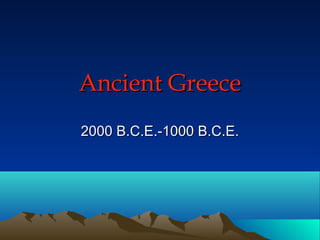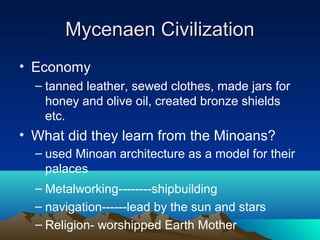ancient greece
- 1. Ancient Greece 2000 B.C.E.-1000 B.C.E.
- 2. Overview of Greece âĒ Physical Setting â Northeast End of the Mediterranean â Consists of Small Peninsulas â Geography âĒ Short mountain ranges cut through mainland âĒ Separate communities âĒ Prevents Unity among Greeks â No clear river system âĒ No unifying meeting place âĒ Prevents Unity â Mild climate, good soil, sufficient rainfall âĒ Farmers can grow grain, grapes, olives âĒ Sheeps, Goats raised in mountains âĒ Not enough to live on
- 4. The Importance of Geography âĒ Geography encourages trade â Long coastline allows all of mainland to be near sea â Islands surrounding have many good harbors âĒ Question: What types of occupations might Greek citizens develop? â (Farmers, fishermen, sailors, traders, explorers)
- 6. The Predecessors of the Greeks âĒ The Minoans â Existed on Crete before Greek Civilization â Legendary in Greek culture, verified in 1900 AD âĒ Archaeologists discover Knossos (palace of King Minos) âĒ Ruins, artifacts discovered since back up finding âĒ Characteristics â Writing: âLinear Aâ (Not been deciphered yet), âLinear Bâ (early form of Greek) âĒ Well established by 2000 BC â Art: created Frescoes (Wall paintings on plaster) âĒ Dominated the Aegean Islands â 1500 BC: Volcano destroys much of Minoan civilization
- 7. The Palace of King Minos King Minosâ palace: built as a labyrinth legendary home of the Minotaur
- 8. Outside King Minosâ palace today
- 9. King Minos' governmental throne room.
- 10. The Mycenaeans âĒ 2000 BC: Groups from the North (Indo- European) âĒ Culture develops around 1600 BC-1200 BC âĒ Warlike group, conquered other areas âĒ Conquered Crete, adopted much of Minoan civilization âĒ 1200 BC: Earthquakes destroy much of civilization
- 11. The palace in Mycenae was surrounded by massive walls with a huge gateway called the Lion Gate
- 12. Mycenaen Civilization âĒ Palaces in the city of Mycenae â served as the centers for government and economy âĒ Government â Role of Tax collectors: âĒ kept track of the wealth of the people living in the kingdom âĒ collected taxes on: wheat, livestock, honey etc.
- 13. Mycenaen Civilization âĒ Economy â tanned leather, sewed clothes, made jars for honey and olive oil, created bronze shields etc. âĒ What did they learn from the Minoans? â used Minoan architecture as a model for their palaces â Metalworking--------shipbuilding â navigation------lead by the sun and stars â Religion- worshipped Earth Mother
- 14. Mycenaen Civilization âĒ Why does the civilization come to an end? â Two Theories: 1. Infighting amongst the kingdoms 2. Invasion by the Dorians
- 15. Dorians âĒ Came in armed with iron weapons âĒ called the âdark ageâ: â Why? âĒ Trade ended, poverty increased, literacy declined âĒ refugees fled to Ionia âĒ 750 B.C.- reintroduced culture, crafts, etc. âĒ Founding of Hellenic Civilization â 700âs B.C.- 350 B.C.














